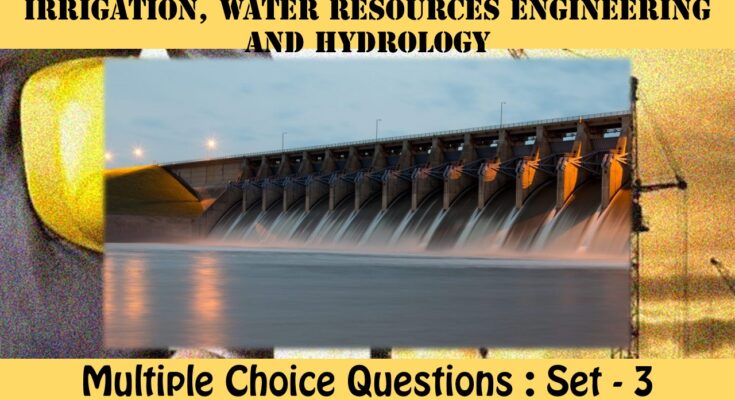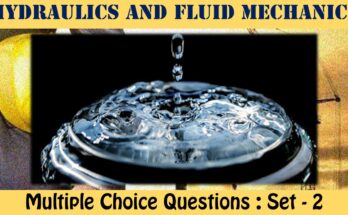MCQ Questions Civil Engineering Irrigation, Water Resources Engineering And Hydrology
The interviewer is almost as nervous as the candidate in most interviews. You might wonder if you look confident enough, if you will hire the right person, or if you are asking the right engineering interview questions. The last question is arguably the most crucial part to worry about when you’re interviewing candidates. Other topics on Civil Engineering Multiple Choice Questions can be accessed
MCQ Questions Civil Engineering Irrigation, Water Resources Engineering And Hydrology - Set - 3
Question 1:
The area between the isohyets 45 cm and 55 cm is 100 square km and between 55 cm and 65 cm is 150 square km. The average depth of annua! precipitation over the above basin of 250 square km will be
a) 50 cm
b) 55 cm
c) 56 cm
d) 60 cm
Correct Answer – (C)
Question 2 :
Unit of runoff in M.K.S. system is
a) cubic metre/sec
b) metre/sec
c) cubic metre
d) square metre
Correct Answer – (A)
Question 3 :
Assertion A : To estimate the rainfall over a catchment, the number of raingauges required per unit area is large for hilly areas.
Reason R : Rainfall gradient is steep. Select your correct answer according to the coding system given below :
a) Both A and R are true and R is the correct explanation of A
b) Both A and R are true but R is not the correct explanation of A
c) A is true but R is false
d) A is false but R is true
Correct Answer – (A)
Question 4 :
A 70% index of wetness means
a) rain excess of 30%
b) rain deficiency of 30%
c) rain deficiency of 70%
d) none of the above
Correct Answer – (B)
Question 5 :
Which of the following types of rain gauges is used for measuring rain in remote hilly inaccessible areas ?
a) tipping bucket type
b) weighing type
c) floating type
d) Simon’s raingauge
Correct Answer – (A)
MCQ Questions Civil Engineering Irrigation, Water Resources Engineering And Hydrology
Question 6:
The runoff increases with
a) increase in intensity of rain
b) increase in infiltration capacity
c) increase in permeability of soil
d) all of the above
Correct Answer – (A)
Question 7:
When surface of transpiration is submerged under water, then potential evapotranspiration is
a) much more than evapotranspiration
b) much less than evapotranspiration
c) equal to evapotranspiration
d) equal to or less than evapotranspi-ration
Correct Answer – (A)
Question 8:
Under the same conditions, which of the following shapes of water surface will give the highest rate of evaporation ?
a) flat water surface
b) convex water surface
c) concave water surface
d) independent of shape of water surface
Correct Answer – (B)
Question 9:
Rate of evaporation from a water surface increases if
i) difference of vapour pressure between water and air is increased
ii) velocity of wind is decreased
iii) concentration of soluble solids in water is decreased The correct answer is
a) (i) and (ii)
b) (i) and (iii)
c) (ii) and (iii)
d) (i). (ii) and (iii)
Correct Answer – (B)
Question 10:
A raingauge should preferably be fixed
a) near the building
b) under the tree
c) in an open space
d) in a closed space
Correct Answer – (C)
- NCERT Solutions Class 12 Mathematics RD Sharma Sets : Exercise 1.1
- NCERT Solutions Class 12 Mathematics RD Sharma Sets : Exercise 1.2
- NCERT Solutions Class 12 Mathematics RD Sharma Sets : Exercise 1.3
- NCERT Solutions Class 12 Mathematics RD Sharma Sets : Exercise 1.4
- NCERT Solutions Class 12 Mathematics RD Sharma Trigonometric Functions : Exercise – 5.1
- NCERT Solutions Class 12 Mathematics RD Sharma Trigonometric Functions : Exercise – 5.2
- NCERT Solutions Class 12 Mathematics RD Sharma Trigonometric Functions : Exercise – 5.3
- NCERT Solutions Class 12 Mathematics RD Sharma Quadratic Equations : Exercise – 14.1
- NCERT Solutions Class 12 Mathematics RD Sharma Quadratic Equations : Exercise – 14.2
- NCERT Solutions Class 12 Mathematics RD Sharma Linear Inequations : Exercise – 15.1
- NCERT Solutions Class 12 Mathematics RD Sharma Linear Inequations : Exercise – 15.2
- NCERT Solutions Class 12 Mathematics RD Sharma Linear Inequations : Exercise – 15.3
- NCERT Solutions Class 12 Mathematics RD Sharma Linear Inequations : Exercise – 15.4
- NCERT Solutions Class 12 Mathematics RD Sharma Linear Inequations : Exercise – 15.5
- NCERT Solutions Class 12 Mathematics RD Sharma Linear Inequations : Exercise – 15.6
Multiple Choice Questions for Competitive Exams
- Multiple Choice Questions Class 12 Chemistry The Solid State
Set -1 Set -2 Set -3 Set -4 Set -5 - MCQ Questions Class 12 Solutions With Answers
Set -1 Set -2 Set -3 Set -4 Set -5 - MCQ Questions Class 12 Electrochemistry With Answers
Set -1 Set -2 Set -3 Set -4 Set -5 - MCQ Questions Class 12 Chemical Kinetics With Answers
Set -1 Set -2 Set -3 Set -4 Set -5 - MCQ Questions Class 12 Surface Chemistry With Answers
Set -1 Set -2 Set -3 Set -4 Set -5 - MCQ Questions Class 12 General Principles and Processes of Isolation of Elements With Answers
Set -1 Set -2 Set -3 Set -4 Set -5




